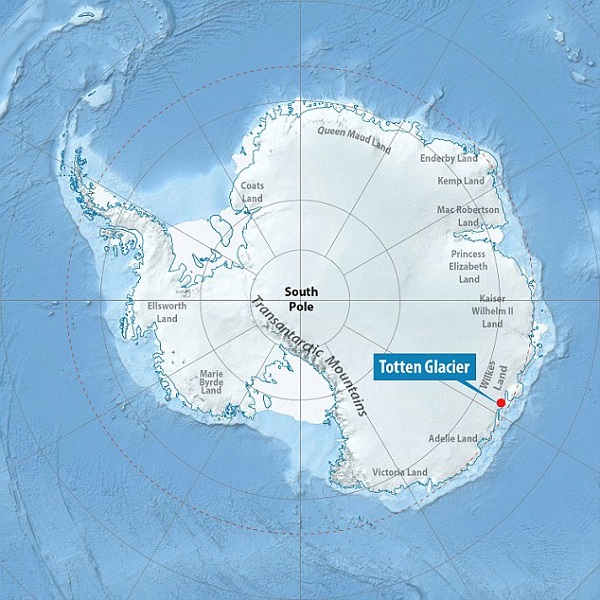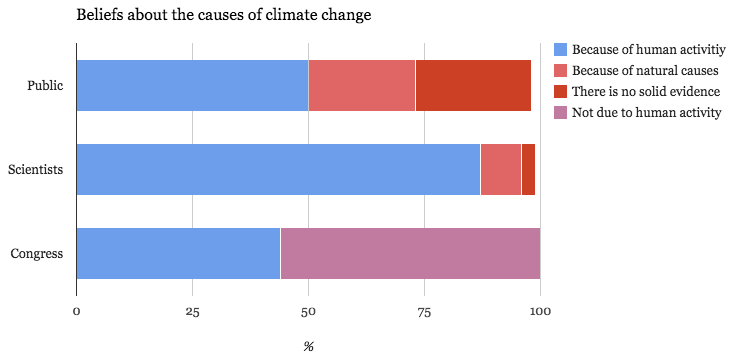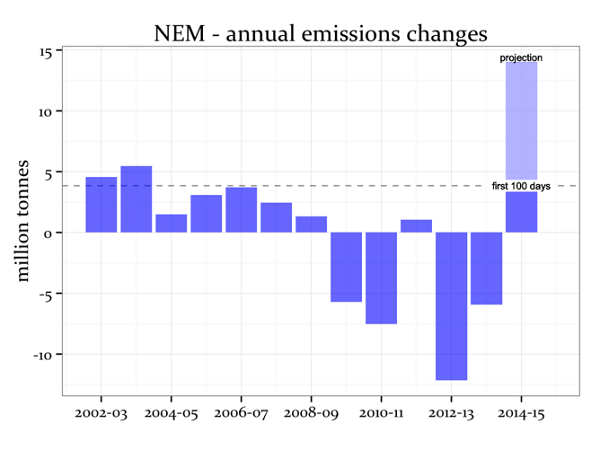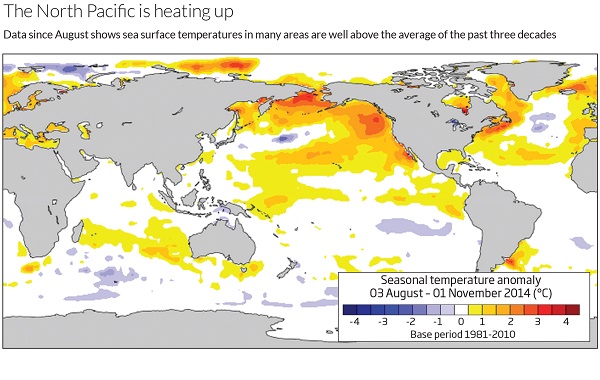1. March scorcher
March temperatures were the hottest March ever and second largest monthly anomaly. Here’s NASA via Open Mind:
March temperatures were the hottest March ever and second largest monthly anomaly. Here’s NASA via Open Mind:
Courtesy of John D, from Gizmag, an item that has implications for algal blooms, health of species, food and methane emissions.
1. Totten Glacier melting from below
Scientists have found that waters around Totten Glacier are warmer than expected and that it is melting from below. Amazingly the glacier, in East Antarctica, has never been studied before.

A team of scientists on the Australian icebreaker Aurora Australis has recently taken a look. They don’t have comparative historical data to go by, but the concern is large. Totten is the biggest of the big and holds enough water to raise the sea level 6 metres. That’s somewhere between West Antarctica and Greenland!
2. State of the Climate 2014
The CSIRO and the Bureau of Meteorology have released their State of the Climate 2014 report. There is a summary at the ABC.
One thing that was new was a prediction of more extreme El Niño and La Niña events. They are talking here of extreme La Niña’s appearing once in 13 years rather than once in 23 years. So it’s not the garden variety events, rather the exceptional events.
For the rest of the report, it seems on a quick look to be much as expected – less rainfall in southern Australia, more extreme hot days, less snow, continued ocean acidification, more worries about sea level rise and so on. I’ll take a closer look if I get time.
Graham Readfearn points out that in 1995 at Amberley near Brisbane the mercury climbed above 35C on 12 days per year on average. That could become 55 days per year.
3. Australian sport needs to lift game on climate issues, Olympians and sport bosses say
It has been a year since extreme heat wreaked havoc at the Australian Open, with players forced to endure temperatures over 40 degrees Celsius on the courts.
Some athletes said the conditions were akin to “tap-dancing on a fry pan”.
Unfortunately Tennis Australia are not on their lonesome in forcing athletes to perform in dangerous conditions. There are concerns also for spectators and venues, for example subject to flooding. The Climate Institute has produced a report analysing the vulnerability amongst sports like AFL, tennis, cricket and cycling as well as winter snow sports.
Part of The Climate Institute’s ongoing research into climate risk and resilience, this report will form the basis of ongoing discussions in the sporting world, including with the newly formed Sports Environment Alliance, chaired by former International Cricket Council CEO Malcolm Speed.
4. Keystone showdown and American climate opinion
The Senate has passed legislation approving the controversial Keystone XL tar sands oil pipeline on a 62-36 vote.
asked Thursday about the vote, White House Press Secretary Josh Earnest reiterated that Obama would veto.
The Senate requires 67 votes to overturn a presidential veto.
Meanwhile Carbon Brief takes a look at the gap in opinion between scientists, the public, and politicians on climate change from Pew Center research. This is how it pans out:

A case of the blind leading the partially sighted.
Across the ditch Hot Topic posts about a book that meticulously goes through the development of climate science from the time of Arrhenius. Seriously, there isn’t an argument any more about the basic science.
5. Economists begin to take climate change, and poverty, seriously
I find this surprising:
current economic models… generally conclude that the economically optimal pathway results in a global surface warming around 3–3.5°C.
Current economic models mainly treat economic growth as an external factor. In these models, global warming and its impacts via climate change don’t significantly affect the rate at which the economy grows.
A new study finds:
while the economies of rich countries continue to grow well in a warmer world, the economic growth of poor countries is significantly impaired.
That’s not so surprising.
The authors find that:
the best path for society would limit temperatures to between 1.6 and 2.8°C warming in 2100, with a best estimate of around 1.7°C warming.
Meanwhile the rulers of the world at the Davos World Economic Forum conference were given a straight message:
In particular, the nexus between climate protection and development is a striking conclusion of the World Bank analysis: without climate stabilization at still manageable levels, development advances, especially in the poorest countries, are set to be reversed. Indeed, development work of past decades (involving significant financial resources) is at risk and with it the well-being of the most vulnerable citizens on Earth.
The “World Bank analysis” is Turn down the heat : confronting the new climate normal, a report prepared for the World Bank by the Potsdam Institute for Climate Impact Research and Climate Analytics.
Turn down the heat : confronting the new climate normal is a massive 320 page report prepared for the World Bank by the Potsdam Institute for Climate Impact Research and Climate Analytics, and hence highly authoritative. Continue reading Turn down the heat : confronting the new climate normal
1. Australia’s coal and gas exports are being left stranded
Just four countries account for 80% of Australia’s fossil fuel exports – China, Japan, Korea and India.
China is on the verge of “peak coal”, rebalancing the economy away from energy intensive industry and introducing a national emissions trading scheme.
Japan is on an energy efficiency drive to reduce its fuel import bill.
Korea has introduced a tax on coal of AU$18 per tonne and is finalising an emissions trading scheme.
India has doubled its tax on coal which funds renewable energy projects and has signalled its intention to stop importing coal within 2-3 years.
Official forecasts are in denial.
2. Are Australian and US climate targets the same?
Environment minister Greg Hunt, Radio National, November 17:
If you use the full Kyoto period — 1990 to 2020 — the US is minus 5% and Australia is almost exactly the same.
Joe Hockey made a similar statement that “If you compare apples with apples, the American position and our position on reductions are effectively the same.”
The comparisons are complex, because the starting and finishing dates are different, so are the population increases. Moreover Australia has forestry and tree clearing in the mix.
Malte Meinshausen and Anita Talberg make the necessary adjustments and find:
An apples-with-apples comparison shows that Australia lags far behind the United States in efforts to reduce greenhouse gas emissions from its energy, transport and industrial sectors.
To match US efforts, Australia would have to increase its 2020 ambitions from the current 5% below 2000 to 21% or even 29%, depending on whether different population growth is taken into account, or not.
In short, they lie!
3. The genius of Tony Abbott’s stance on climate

At New Matilda Tom Allen comments on Tom Switzer’s claim the Abbott is a climate change genius. Switzer is a climate change denialist, so we won’t bother with that! Allen finds Abbott has proved one thing – that a carbon tax works!
Abbott
will be remembered as the Prime Minister who proved that the carbon tax worked. After it was introduced, Australia’s carbon dioxide emissions fell, the economy continued to grow and the sky remained in place.
When Abbott repealed it and the country’s emissions began to rise again, using Australia as a vast laboratory, Abbott confirmed it: carbon taxes work.
4. Record growth in electricity sector emissions
Abbott’s genius is demonstrated by this graph of emissions change from electricity production:

The reductions started well before the carbon ‘tax’, but whatever the reason Abbott seems to have made a difference.
WORST. PRIME MINISTER. EVER!!
As Tom Allen said, it’s nothing personal.
The worst things about him are his policies, and his stance on climate change is worst of all.
5. Record-breaking ocean temperatures
The world’s oceans are the hottest they’ve ever been in the modern record, especially in the northern Pacific.
In July this year, ocean surfaces were 0.55 °C above the average since 1890, just beating the previous record of 0.51 °C in 1998. In the North Pacific, the temperatures were about 0.8 °C above average, which is 0.25 °C warmer than the 1998 peak.

No explanation is given as to why this pattern has emerged. However, it does seem to be disrupting the development of an El Niño. Small mercy, because the northern Pacific warming has effects similar to an El Niño:
This includes more hurricanes in the Pacific, as well as more storms curling over into mainland US. Meanwhile, there have been fewer hurricanes in the Atlantic, just as happens during El Niño. Elsewhere, dry conditions have occurred across Australia, and the Indian monsoon was delayed – effects all arising from warm oceans, despite the lack of an El Nino event.
6. Turn down the heat : confronting the new climate normal
This is volume 2 of 2 of a report prepared for the World Bank by the Potsdam Institute for Climate Impact Research and Climate Analytics, and hence highly authoritative. The lead author was Hans Joachim Schellnhuber of the Potsdam Institute.
It’s a massive 320 page report. This is from the Foreword:
There is growing evidence that warming close to 1.5°C above pre-industrial levels is locked-in to the Earth’s atmospheric system due to past and predicted emissions of greenhouse gases, and climate change impacts such as extreme heat events may now be unavoidable.
As the planet warms, climatic conditions, heat and other weather extremes which occur once in hundreds of years, if ever, and considered highly unusual or unprecedented today would become the “new climate normal” as we approach 4°C—a frightening world of increased risks and global instability.
The consequences for development would be severe as crop yields decline, water resources change, diseases move into new ranges, and sea levels rise. Ending poverty, increasing global prosperity and reducing global inequality, already difficult, will be much harder with 2°C warming, but at 4°C there is serious doubt whether these goals can be achieved at all.
That’s about as far as I could get tonight. Climate Progress has a post.
 These posts are intended to share information and ideas about climate change and hence act as an open thread. This post has emphasised science, observations and impacts. Comments, about science, observations impacts, and future predictions are welcome. I do not, however, want a rehash of whether human activity causes climate change.
These posts are intended to share information and ideas about climate change and hence act as an open thread. This post has emphasised science, observations and impacts. Comments, about science, observations impacts, and future predictions are welcome. I do not, however, want a rehash of whether human activity causes climate change.
Roger Jones at Understanding Climate Risk has a post on global warming breaking the link between SAM and ENSO, with consequences for our weather.
To help, GMT in the graph means ‘global mean temperature’.

With the global warming signal taken out (top panel), the relationship between ENSO and SAM is strong but with it in, they depart in the late 1960s (lower panel).
There’s also an article in The Age.
From Jones:
So what does this mean for Australia’s climate? It means that an overwhelmingly positive SAM is keeping the westerlies south and contributing to our drier autumn winters and delivering weather typical of the Riverina to southern Victoria according to Cai. Recovery of the ozone layer and reduction in greenhouse gas emission would stabilise this process, rather than continuing to send it south.
In summer it also allows the easterly trades greater access, bringing in more moisture from the tropics and enhancing La Niña summer rainfall. Continue reading Climate clippings 79